15 Foods Never to Feed Your Baby
- Which foods are choking foods…and how to modify them so they are safe for your baby to eat.
- How much sodium per serving you want to stay under when choosing foods for your baby to eat.
- Why the most common food for starting solid foods is actually dangerous for babies.
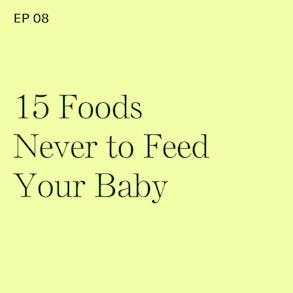
LISTEN TO THIS EPISODE
Episode Description
Which foods should babies avoid? Babies can eat so many more foods than we give them credit for - but certain foods are choking risk foods or are harmful to developing babies for other reasons. This episode contains 15 foods to not feed your baby in order to preserve their health.
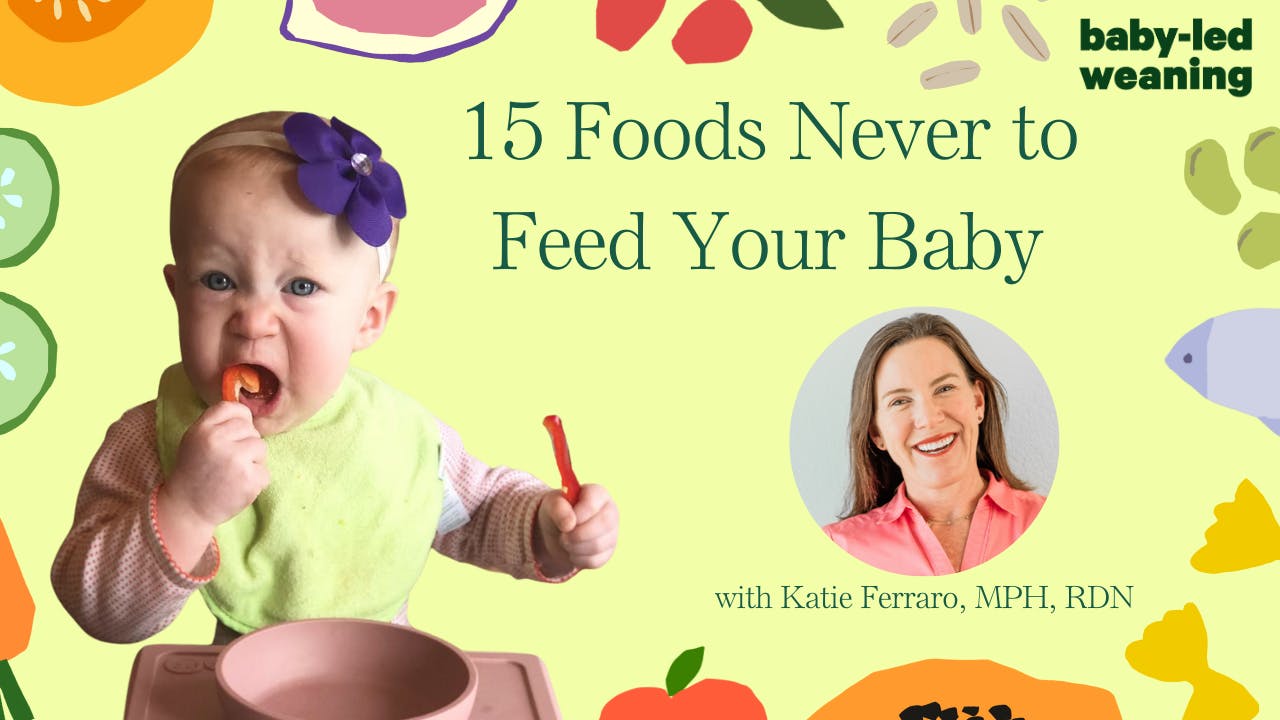
Links from This episode
- Download the 15 Foods Never to Feed free feeding guide here.
- Baby-Led Weaning with Katie Ferraro program with the 100 First Foods™ Daily Meal Plan, join here: https://babyledweaning.co/program
- Baby-Led Weaning for Beginners free online workshop with 100 First Foods™ list to all attendees, register here: https://babyledweaning.co/baby-led-weaning-for-beginners
Other Episodes Related to This Topic
- Episode 27 - Honey: Why Honey is Dangerous for Babies
- Episode 107 - Corn: How to Offer Corn Safely to Your Baby
- Episode 208 - Heavy Metals in Baby Food with @consumerreports James E. Rogers, PhD
- Episode 232 - Tuna Talk: Is it Safe for Babies to Eat Canned Tuna with @consumerreports Michael K. Hansen, PhD
- Episode 246 - Arsenic in Baby Food with Charlotte Brody, RN and Jane Houlihan
Resources and Research
- "Added sugar in kids' diets: How much is too much?" AAP News, American Academy of Pediatrics, March 25, 2019, https://publications.aap.org/aapnews/news/7331/Added-sugar-in-kids-diets-How-much-is-too-much
- American Academy of Pediatrics. "Fruit Juice in Infants, Children, and Adolescents." Pediatrics, vol. 139, no. 6, 2017, article e20170967,https://publications.aap.org/pediatrics/article/139/6/e20170967/38754/Fruit-Juice-in-Infants-Children-and-Adolescents.
- Bright Futures / American Academy of Pediatrics. Recommendations for Preventive Pediatric Health Care. Available at: www.pediatriccare.solutions.aap.org.
- U.S. Food and Drug Administration. "ADVICE ABOUT EATING FISH For Those Who Might Become or Are Pregnant or Breastfeeding and Children Ages 1 – 11 Years." FDA, https://www.fda.gov/media/102331/download.

Latest Episodes
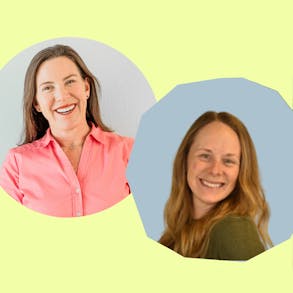
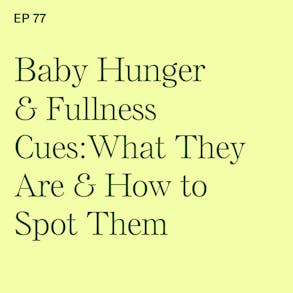
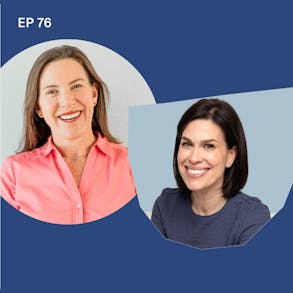
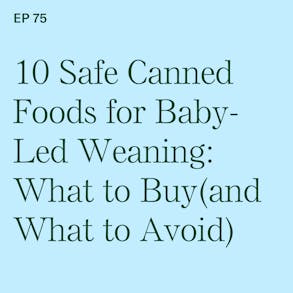
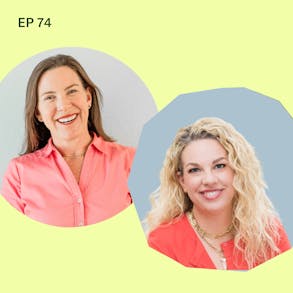
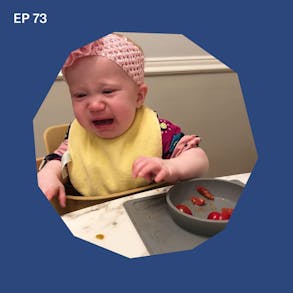
Bumble (1s):
Look, Bumble knows you're exhausted by dating all the must not take yourself too seriously. And six one since that matters. And what do I even say other than, hey, well that's why they're introducing an all new Bumble with exciting features to make compatibility easier, starting the chat better and dating safer. They've changed so you don't have to Download the new Bumble now
Katie Ferraro (28s):
Checking in on your infant refresher CPR core status. Have you taken CPR recently? Actually, everybody who helps feed your baby should know CPR, because while there's no higher risk of choking with Baby-Led Weaning compared to conventional spoon feeding, CPR can save your baby's life. The course I take every quarter is available online. It's incredibly thorough, but it's also concise. You can get $10 off your online CPR course registration with my affiliate discount code Katie 10. The website you sign up at is bit.ly/onlineCPRcourse. So the regular use of rice foods and rice drinks, that's not recommended for babies because of the potential for arsenic toxicity. So sometimes you'll hear parents like, oh, I'm just gonna start with some white rice cereal.
Katie Ferraro (1m 9s):
But certain crops like rice and sweet potatoes, they preferentially take up arsenic, which is a heavy metal that can impair your baby's health and development. So sure you can offer rice foods in moderation, and there's techniques for like cooking rice and high quantities of water in order to lower the arsenic content. But we really, for the most part want to avoid regular use of rice foods and rice drinks for babies. Hey there, I'm Katie Ferraro, registered dietitian, college nutrition professor and mom of seven specializing in Baby-Led Weaning. Here on the Baby-Led Weaning with Katie Ferraro podcast. I help you strip out all of the noise and nonsense about feeding, giving you the confidence and knowledge you need to give your baby a safe start to solid foods using Baby-Led Weaning.
Katie Ferraro (1m 56s):
I am gonna be honest about my chosen profession of nutrition as a Registered dietitian and having been a dietitian for more years of my life now than I have not been a dietician. I feel like I'm qualified to say this, but dietitians get a bad rep. They're oftentimes accused of being the food police. I remember when I was a new dietician working in clinical and inpatient, my least favorite thing was when the nurses would come up and be like, Katie, we're out of jello on the third floor. And it's like, go get yourself some freaking jello. Or they'd be like, go, no, that patient doesn't like that. Go in there and take his food preferences. Or like this cardiac patient's about to be discharged. Go in there and tell him all the foods that he shouldn't eat so he doesn't have another heart attack. Like this food police persona certainly follows a lot of dietitians around.
Katie Ferraro (2m 36s):
And now that I focus on infant feeding and Baby-Led Weaning and have done so for nearly a decade, what I love most about this space is that I can focus on all of the foods that babies can eat, right? There's definitely sites out there and other, you know, so-called experts that just give you long lists of all the things you shouldn't do for Baby-Led Weaning. And these are the foods your baby shouldn't eat. And part of the reason why I put together my original 100 First Foods List back in 2016 is that I wanted parents to see like, oh my gosh, look at all of these foods that my baby can eat. Okay? And so there are a 100 Foods on the original 100 First Foods List, and lots of families keep going, and they do more than that, okay?
Katie Ferraro (3m 16s):
There are some foods that we don't offer babies, primarily because they're choking hazards. And I like to start out each of these mini training episodes by providing you with a Baby-Led Weaning tip of the day. And today's tip is, I know that choking and choking prevention is top of mind for you right now, and certainly that is important. But today I am gonna share with you 15 foods that you should never feed your baby. And some of the foods on this list have totally different reasons for why we don't give them to babies. And I want you to hang tight because in this episode, I'm actually gonna walk you through the 15 foods that we want to steer clear of, and then I'll tell you how to get more info about how you can modify those same foods so that they actually are safe.
Katie Ferraro (3m 57s):
'Cause it's one thing to say like, oh, here's a long list of foods your baby shouldn't eat. Okay? And again, I know there's a lot of that out there, and that's sometimes why Baby-Led Weaning can get a negative reputation as being super judgy. And I want you to think of all the foods your baby can eat, but I also want you to be educated about what your baby shouldn't eat, okay? And when we're talking about choking hazard, for example, so his parents will be like, apples are dangerous. Like, well, yeah, raw slices of hard, crunchy, crispy apple with the peel on are dangerous for babies to eat. But if you peel an apple, if you core the apple, if you slice it, if you poach it, and then if you cut it into the right size and offer it to your baby when they're ready to start solid foods and they're seated safely and they're height, you're like, it's a totally safe food. So again, a lot of the foods that you'll find here in this episode that we avoid will be because they are choking risk.
Katie Ferraro (4m 40s):
But I'm also going to include, in addition to choking risk foods, some foods that are health risk foods as well as some general health concern foods. So I wanna tell you a quick story before we get started. When it comes to peels, parents oftentimes have lots of questions. In my program, we do not offer baby foods with peels on bananas, for example, okay? Think about a banana like do you eat a banana with its peel on? No, of course not. Okay? There are sites out there that say, oh, you should offer your baby a banana with part of the peel on so it's easier for them to grip. So the story is this one time this mom emails me and she said, "I gave my baby a banana with a peel on it" . And I turned around for a second, and when I looked back, the baby was choking on the banana peel.
Katie Ferraro (5m 21s):
You should tell other parents about this. I learned it in your program that you should offer the peel, but that's really dangerous. And I told this mom like red flag right away. No way. Would you ever see advice for me about offering a banana with a peel on? Okay. I've fed hundreds of babies bananas at this point, specialized in Baby-Led Weaning. My primary concern is safe preparation of foods for your baby. That lipstick banana trick. I think that's a gimmicky social media way to grab your attention. Babies don't eat banana peels, you guys, they choke on them. So sure enough, check our database. This mom was not in our program. She saw it on some other unsafe Baby-Led Weaning resource out there. And I just wanna remind you, like go with your gut. Okay? You guys know offering your baby in edible parts of food like banana peels is not safe.
Katie Ferraro (6m 7s):
Now, technically you can eat banana peels, okay? It's an ingredient in recipes and some other food cultures. But again, if you can't shred the food between your fingers and your thumb, as I always say, then it's not safe for your baby to eat with their gums. So stick to the bananas and not the banana peels. Alright, before we dive in to the list of 15 Foods Never to Feed, Your Baby, you don't need to write all of this down. Okay? Some of you're driving or pumping or nursing or doing dishes or walking, whatever it is, I have a feeding guide already all put together that is free. It's called 15 Foods Never to Feed Your Baby. And it expands on each of the 15 foods that I'm about to cover here in this episode. So in this episode, I'll be sharing with you why we don't feed those foods, but if you wanna get the solution on how you make those foods safe for your baby, I have this free feeding guide linked up for you on my website at babyledweaning.co/resources.
Katie Ferraro (7m 3s):
Again, that's babyledweaning.co/resources to get the full 15 foods Never to Feed feeding guide. So let's take a look at those 15 Foods Never to Feed Your Baby. And I wanna start with the first one, which is a food we want your baby to eat, which is peanuts and tree nuts. 'Cause those are two separate allergenic food categories, but thick globs of nut butters are a choking hazard. Thick globs of nut butter, like peanut butter or almond butter. They can easily become lodged on the roof or the sides of your baby's mouth. Now, there's lots of ways that we can make those foods and peanuts and tree nuts safer for babies to eat, but don't do the thick globs of nut butter again because they can be a choking hazard.
Katie Ferraro (7m 46s):
Hey, we're gonna take a quick break, but I'll be right back.
BetterHelp (7m 50s):
This episode is brought to you by BetterHelp. If you've been thinking about giving therapy a try, BetterHelp is a great option. It's a convenient, flexible, affordable, and entirely online experience. All you do is just fill out a brief questionnaire to get matched with a licensed therapist, and you can also switch therapists at any time for no additional charge. I used to think therapy was just for people who have experienced major trauma, but therapy can help you be at your best no matter what you're going through. So whether it's to learn new positive coping skills, set more realistic boundaries, or just show up as a better version of yourself, BetterHelp is here to help. Therapy can help you find what matters to you so that you can do more of it. If you wanna live a more empowered life, therapy can help you get there and betterHelp can help you. Visit betterHelp.com/weaning today to get 10% off your first month. That's betterhelp.com/weaning and get 10% off your first month.
Katie Ferraro (9m 5s):
The second choking risk food are whole intact nuts. So whole intact nuts or crunchy pieces of nuts are a choking hazard for early eaters. And I can show you how to utilize nut flowers and thinned out nut butters or baby nut puffs. There's lots of other ways to do it, but don't go given your baby whole intact nuts. Number three, whole grapes or whole cherry or grape tomatoes. So whole grapes or whole cherry tomatoes and whole grape tomatoes are a choking hazard for babies. Okay? If you look at the emergency room admission data for non-fatal choking incidences in the pediatric population, grapes are oftentimes cited. You're like, oh my gosh, grapes are a huge choking hazard. One of the biggest problems with grapes is that it's when children are running around and eating grapes, they fall and the grape becomes lodged in their airway.
Katie Ferraro (9m 50s):
That's what causes choking. Okay? your baby can safely have grapes, but we don't offer whole intact grapes to early eaters. And always remember that as your child becomes more mobile, grapes are a choking hazard because when grapes combined with mobility, so kids running around trip and fall, that's when they choke. So you can cut up the grapes safely. We generally quarter grapes for babies up until age one, and then even cutting the grapes in half after age one can help lower their choking risk and never let your child run around or be out of their chair when they're eating. 'Cause if they drip and fall, that's when the choking will occur. Number four is rock crunchy fruits and vegetables. So I mentioned apples, right? Rock, crunchy, crispy fruits and vegetables.
Katie Ferraro (10m 31s):
Those are choking hazards for babies. We don't give solid pieces of raw apple to a baby, okay? Raw apples are also routinely cited as one of the most dangerous foods for children. But you can peel and corn and cut and poach and cook many fruits and vegetables to make them softer for babies to self feet. Dried fruits like raisins and prunes are a choking hazard for babies. Sticky dried fruits can easily become lodged on the roof or the sides of your baby's mouth. So you can make dried fruits into homemade purees and offer them from a preloaded spoon or out of an open cup. And one of my favorite recipes in our program is our homemade apple pear prune puree. I use this in place of jelly all the time for older kids. Peanut butter and jelly sandwiches.
Katie Ferraro (11m 11s):
It's also awesome to thin out and practice out of an open cup. It's a wonderful recipe if your baby is feeling some constipation as well. Number six, popcorn. Popcorn is a choking hazard, okay? But we, you want your baby to have corn, especially if it's a food that you enjoy. So a safer way to offer babies Corn is I love to make homemade polenta. So you take one cup of Corn meal, you mix it with three cups of water and boil it, stir it until it's thick, cool it, and then offer it to your baby from a preloaded spoon. If you're feeling like the pressure, oh, I wanna do some cereals off of a preloaded spoon, skip all the silly baby food cereals. Make some homemade polenta. The penta you buy at the store is way too high in salt for your baby, but certainly steer clear of popcorn. Now, hard and gummy candies are number seven, and people roll their eyes like, well, who would give a baby candy?
Katie Ferraro (11m 55s):
Hey, hard and gummy candies are a choking risk for babies and children. And it's not the parents who are feeding the babies. The jolly Ranchers, right? Be aware that babies might be given these foods by older children in the household, or especially when they start crawling and getting mobile, they find and consume these on their own. So just be super aware if you have any of these hard or gummy candies in your house. Okay, so those are seven of the first 15. The choking risk foods to summarize thick globs and nut butter. Number two, whole intact nuts. Number three, whole grapes, cherry or grape tomatoes. Number four, raw crunchy fruits and vegetables. Number five, dried fruits. Number six, popcorn. And number seven, hardened gummy candies. In the next section I wanna mention health risk foods.
Katie Ferraro (12m 35s):
So these are foods that we don't offer to babies and and by babies we generally mean under the age of one. And that's because these foods pose a potential health risk. So number eight, the first food on the health risk part of the list are unpasteurized raw foods and drinks. So unpasteurized raw foods and drinks such as raw milk, raw cheese, unpasteurized juices, and ciders can cause a foodborne illness. These foods and drinks have been linked to listeria, e coli and other foodborne illness outbreaks. So pasteurization is a process whereby manufacturers heat foods to a temperature that kills any potentially harmful pathogens. Pasteurization does not alter the nutrition content of the foods or the drinks, but make sure as you move through the new foods and drinks your baby, you're trying that they are indeed pasteurized.
Katie Ferraro (13m 17s):
And I know a lot of you are already on the lookout for that 'cause you knew about the foodborne illness risks associated with unpasteurized foods from the time when you were pregnant. So that kind of carries over to your baby with their still developing immune system. We want that pasteurization to kill any of the potentially harmful pathogens. Number nine on the 15 Foods Never to Feed Your Baby list fluid cow's milk in place of infant milk. So fluid cow's milk is not an appropriate replacement for infant milk. Infant milk is breast milk and or formula, and that holds true for babies up until 12 months of age. Now your baby, certainly between six and 12 months of age, can have cow's milk, can have dairy foods, can have ingredients that have cow's milk in them as part of the weaning diet.
Katie Ferraro (13m 57s):
But fluid cow's milk is nutritionally incomplete for infants and should not be substituted for breast milk and or formula. You can switch to cow's milk when your baby turns one. We generally start with whole cow's milk. Do whole milk products up until age two. So we try to avoid reduced fat, non-fat, low fat dairy foods for children who are one and two, because babies need that fat for their still developing brain. Stick with the infant formula and the breast milk until your baby turns one when they're also trying solid foods. Alright, number 10, the next food that is a potential health risk food for babies is honey. So honey and other syrups should be avoided for babies under the age of 12 months because of the risk for botulism.
Katie Ferraro (14m 37s):
So your babies still developing immune system cannot prevent the spores of clostridium botulinum from growing like adults can. So honey and syrups are also added sugars which are not appropriate for infants anyway. So skip the Honey. Number 11 includes high mercury fish. Certain types of large fish may contain higher levels of mercury, and that's a heavy metal that it can can impair your baby's health and their development. The highest level of mercury fish that the United States government recommends to avoid include king mackerel, marlin, orange, ruffy, shark, swordfish tile fish from the Gulf of Mexico and big eye tuna. Now on my 100 First Foods List, we have sardines and we have white fish and we have fatty fish. We've got a lot of different shellfish opportunities 'cause both fin fish and shellfish represent two separate allergenic food categories.
Katie Ferraro (15m 21s):
I don't want you to be scared of offering your baby fish 'cause we want that fish and that shellfish protein in their systems to help lower the risk of food allergy down the road. We just don't want you offering the high mercury ones. Number 12 is the regular use of rice foods and drinks. So regular use of rice foods and drinks is concerning. It's not recommended for babies because of the potential for arsenic toxicity. So arsenic is a heavy metal that can impair your baby's health and development. So instead, we wanna offer rice foods in moderation. You can do things like cooking rice and high quantities of water in order to lower arsenic and also avoid rice drinks for babies. The next category foods 13, 14, and 15 are not so much health risk foods, but just general health concerns.
Katie Ferraro (16m 5s):
So food number 13, do avoid includes any food with added sugar. The American Academy of Pediatrics recommends no added sugars for children under the age of two. So when you're reading your food labels, you'll often be, you know, gosh, what do I buy for my baby? Just go to the added sugars line. And if it says zero grams of added sugar, that's check in the box for you. Okay? That's a no sugar added food. There's a few other things to look out for, which leads me into food number 14, which is any food with excess salt? Okay, now, excess salt is kind of a subjective term. There's no hard and fast rules about how much sodium babies need or should have. We've done a lot of podcast episodes on sodium. One of my favorite podcast episodes of all time was sodium limits around the World. Basically went and looked at all the different countries that have sodium regulations about babies.
Katie Ferraro (16m 48s):
And spoiler alert, nobody knows, "how much salt a baby needs". But we do know that offering excessive salty foods is a good idea. 'Cause babies need to explore the flavors of the foods and not the salty additives. So my rule of thumb is that I look for less than 100 milligrams of sodium per serving of packaged food if I'm going to offer it to my baby. Okay, so we wanna avoid both foods with added sugar. That's number 13. And foods with excess salt. That's number 14. Food number 15 on the list is for fruit juice. Okay? Do not offer babies fruit juice. Babies can eat fruit, they just don't need to drink it. Okay? Fruit juice consumption in childhood has been linked to dental caries, which are cavities and excessive weight gain.
Katie Ferraro (17m 28s):
The American Academy of Pediatrics recommends complete avoidance of juice for babies, and I agree with them, your baby, just like you can and should eat fruit, and you don't need to rely on juice. Hey, we're gonna take a quick break, but I'll be right back.
Disney and Pixar (17m 46s):
This is Amy Poer, my new movie, Disney and Pixar's Inside Out too is coming to theaters June 14th, and it's making me feel joy and sadness and anger. Definitely some disgust rose and I think a little fear really. But I'm also feeling these new emotions like anxiety, embarrassment, envy, and on week, it's what you call the boredom. Okay, that one was weird. It's gonna be the feel Everything Movie of the Summer, Disney and Pixar's Inside Out Two, only in theater's. June 14th. Get tickets now.
Katie Ferraro (18m 21s):
So to summarize the second half of the list, the health risk foods, we want to avoid unpasteurized raw foods and drinks. Number nine, stay away from fluid cows milk in place of infant milk up until age one. Number 10, no honey for babies. Number 11, avoid the high mercury fish. Number 12, steer clear of regular use of rice foods and rice drinks. And then as far as general health concerns go for number 13, we steer clear of foods with added sugar. Number 14, minimize foods with excess salt. And number 15, no fruit juice for your babies. Again, you can grab the whole free feeding guide with all of these foods on it with more information and more resources on how to make them safe. If you head to babyledweaning.co/resources, the free feeding guide called 15 Foods Never to Feed Your Baby will be there.
Katie Ferraro (19m 6s):
And if you would like recipes and ideas on how to make all of those foods safe, they're all inside of my signature online program called Baby-Led Weaning with Katie Ferraro. This is the program that has my 100 First Foods content library with all the videos and the recipes and the instructions on how to make all the foods from the 100 First Foods List safe for your baby's ages and stages. It also has my 100 First Foods Daily Meal Plan. So if you're like, okay, I got what I shouldn't feed my baby, but just tell me which foods to feed them in which order. I've got 20 weeks of meal plans that get you to a 100 First Foods, all of the daily recipes, the weekly grocery lists, the menus that's all part of that Baby-Led Weaning with Katie Ferraro Program.
Katie Ferraro (19m 46s):
You can sign up at babyledweaning.co/program. I'll put all the links from this episode, including where you get that free feeding guide, as well as how to join my program. If you wanna make all these foods on the 100 First Foods List for your baby, those will all be on the show notes, which are located at blwpodcast.com slash eight. A special thank you to our partners at AirWave Media. If you like podcasts that feature food and science and using your brain, check out some of the podcasts from AirWave. We're online@blwpodcast.com. Thanks again for listening, and I'll see you next time.
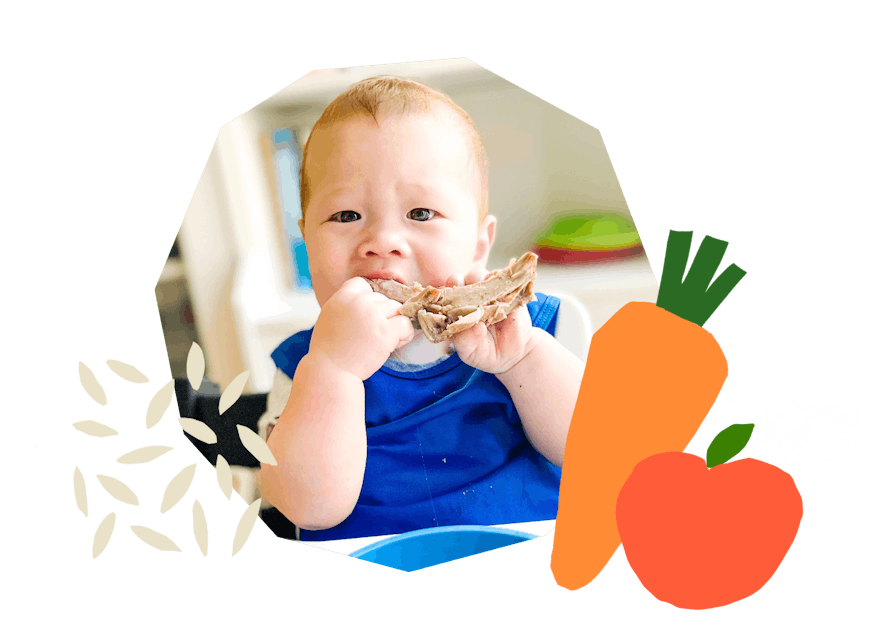
The Program Baby-Led Weaning with Katie Ferraro
A step-by-step digital program for starting solid foods safely and navigating the original 100 FIRST FOODS™ meal plan with baby-led weaning.
 EXPERT-LED, PROVEN APPROACH TO EATING REAL FOOD
EXPERT-LED, PROVEN APPROACH TO EATING REAL FOOD CONCISE VIDEO TRAININGS TO MASTER BABY-LED WEANING
CONCISE VIDEO TRAININGS TO MASTER BABY-LED WEANING 100 FIRST FOODS DAILY MEAL PLAN WITH FOOD PREP VIDEOS
100 FIRST FOODS DAILY MEAL PLAN WITH FOOD PREP VIDEOS
Baby-Led Weaning for Beginners Free Workshop
Is your baby ready to start solid foods, but you’re not sure where to start? Get ready to give your baby a solid foundation to a lifetime of loving real food…even if you’re feeling overwhelmed or confused about this next stage of infant feeding.
Get baby-led weaning recipes and tips delivered to your email inbox.


